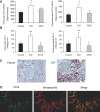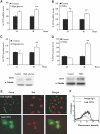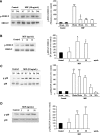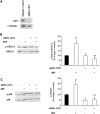The MIF receptor CD74 in diabetic podocyte injury
- PMID: 18842989
- PMCID: PMC2637042
- DOI: 10.1681/ASN.2008020194
The MIF receptor CD74 in diabetic podocyte injury
Abstract
Although metabolic derangement plays a central role in diabetic nephropathy, a better understanding of secondary mediators of injury may lead to new therapeutic strategies. Expression of macrophage migration inhibitory factor (MIF) is increased in experimental diabetic nephropathy, and increased tubulointerstitial mRNA expression of its receptor, CD74, has been observed in human diabetic nephropathy. Whether CD74 transduces MIF signals in podocytes, however, is unknown. Here, we found glomerular and tubulointerstitial CD74 mRNA expression to be increased in Pima Indians with type 2 diabetes and diabetic nephropathy. Immunohistochemistry confirmed the increased glomerular and tubular expression of CD74 in clinical and experimental diabetic nephropathy and localized glomerular CD74 to podocytes. In cultured human podocytes, CD74 was expressed at the cell surface, was upregulated by high concentrations of glucose and TNF-alpha, and was activated by MIF, leading to phosphorylation of extracellular signal-regulated kinase 1/2 and p38. High glucose also induced CD74 expression in a human proximal tubule cell line (HK2). In addition, MIF induced the expression of the inflammatory mediators TRAIL and monocyte chemoattractant protein 1 in podocytes and HK2 cells in a p38-dependent manner. These data suggest that CD74 acts as a receptor for MIF in podocytes and may play a role in the pathogenesis of diabetic nephropathy.
Figures








Similar articles
-
Activation of the JNK signalling pathway by macrophage migration inhibitory factor (MIF) and dependence on CXCR4 and CD74.Cell Signal. 2011 Jan;23(1):135-44. doi: 10.1016/j.cellsig.2010.08.013. Epub 2010 Aug 31. Cell Signal. 2011. PMID: 20807568 Free PMC article.
-
MIF regulates T helper 17 cell differentiation by activating the p38 MAPK signaling pathway to drive the pathogenesis of EAP.Int Immunopharmacol. 2025 Jun 26;159:114959. doi: 10.1016/j.intimp.2025.114959. Epub 2025 May 28. Int Immunopharmacol. 2025. PMID: 40440956
-
Macrophage Migration Inhibitory Factor Mediates Proliferative GN via CD74.J Am Soc Nephrol. 2016 Jun;27(6):1650-64. doi: 10.1681/ASN.2015020149. Epub 2015 Oct 9. J Am Soc Nephrol. 2016. PMID: 26453615 Free PMC article.
-
CD74 in Kidney Disease.Front Immunol. 2015 Sep 23;6:483. doi: 10.3389/fimmu.2015.00483. eCollection 2015. Front Immunol. 2015. PMID: 26441987 Free PMC article. Review.
-
MIF, CD74 and other partners in kidney disease: tales of a promiscuous couple.Cytokine Growth Factor Rev. 2013 Feb;24(1):23-40. doi: 10.1016/j.cytogfr.2012.08.001. Epub 2012 Sep 7. Cytokine Growth Factor Rev. 2013. PMID: 22959722 Review.
Cited by
-
Suppressors of cytokine signaling abrogate diabetic nephropathy.J Am Soc Nephrol. 2010 May;21(5):763-72. doi: 10.1681/ASN.2009060625. Epub 2010 Feb 25. J Am Soc Nephrol. 2010. PMID: 20185635 Free PMC article.
-
Acyloxyacyl Hydrolase Protects against Kidney Injury via Inhibition of Tubular CD74-Macrophage Crosstalk.Int J Biol Sci. 2024 May 19;20(8):3061-3075. doi: 10.7150/ijbs.91237. eCollection 2024. Int J Biol Sci. 2024. PMID: 38904010 Free PMC article.
-
CD74 Promotes Cyst Growth and Renal Fibrosis in Autosomal Dominant Polycystic Kidney Disease.Cells. 2024 Mar 11;13(6):489. doi: 10.3390/cells13060489. Cells. 2024. PMID: 38534333 Free PMC article.
-
High glucose up-regulates angiotensin II subtype 2 receptors via interferon regulatory factor-1 in proximal tubule epithelial cells.Mol Cell Biochem. 2010 Nov;344(1-2):65-71. doi: 10.1007/s11010-010-0529-z. Epub 2010 Jul 2. Mol Cell Biochem. 2010. PMID: 20596758 Free PMC article.
-
Chemokine profile in the sera and urine of patients with schistosomal glomerulopathy.Am J Trop Med Hyg. 2014 Jan;90(1):48-53. doi: 10.4269/ajtmh.13-0270. Epub 2013 Nov 4. Am J Trop Med Hyg. 2014. PMID: 24189364 Free PMC article.
References
-
- Mora C, Navarro JF: Inflammation and diabetic nephropathy. Curr Diab Rep 6: 463–468, 2006 - PubMed
-
- Tesch GH: MCP-1/CCL2: A new diagnostic marker and therapeutic target for progressive renal injury in diabetic nephropathy. Am J Physiol Renal Physiol 294: F697–F701, 2008 - PubMed
-
- Morand EF, Leech M, Bernhagen J: MIF: A new cytokine link between rheumatoid arthritis and atherosclerosis. Nat Rev Drug Discov 5: 399–410, 2006 - PubMed
-
- Lan HY, Yang N, Nikolic-Paterson DJ, Yu XQ, Mu W, Isbel NM, Metz CN, Bucala R, Atkins RC: Expression of macrophage migration inhibitory factor in human glomerulonephritis. Kidney Int 57: 499–509, 2000 - PubMed
Publication types
MeSH terms
Substances
Grants and funding
LinkOut - more resources
Full Text Sources
Medical
Research Materials
Miscellaneous

